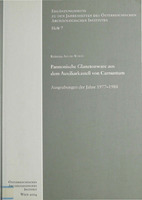Pannonische Glanztonware aus dem Auxiliarkastell von Carnuntum
Ausgrabungen der Jahre 1977-1988
Author(s)
Adler-Wölfl, Kristina
Collection
Austrian Science Fund (FWF)Language
GermanAbstract
The "Pannonische Glanztonware" (PGW) is a type of ceramics, which was wide-spread in Pannonia from the end of the 1st well into the 3rd century A.D. It is a product of local potteries, in which the influence of ceramics in the La Tène tradition and of imported Roman ceramics joined to create a new, typical Pannonian ware.
In the PGW was produced exclusively table ware. The shapes of the vessels are to a large extent taken over from the Terra Sigillata resp. influenced by it; some of them also show the influence of the raetic-germanic area and the local utility ware.
The vessels have a fine paste, a slip and are fired at the beginning of production, in most cases in a reducing atmosphere. But from the beginning oxidized fired pieces also appeared; their portion is - regionally scattered - increasing in the 3rd century.
A number of the vessels are decorated in a for typical PGW way with stamps either inside at the base or outside; most of them, however are undecorated.
The basis of the investigations into the PGW are the finds, which were unearthened at the excavations 1977-1988 conducted by H. Stiglitz in the auxiliary fort of Carnuntum. The finds of the "Steinkastell I" and the over it lying levelling layer give a representative view of the PGW in the second third of the 2nd century in the area of Carnuntum.
On the basis of the finds published here, a open classification-system was created, so that it can be expanded with further finds, which are until now only known from unpublished locations or from other publications.
Regarding the material of the vessels five fabrics ("STyp 1-5") and four types of slip ("ÜTyp A-D") could be distinguished. Petrographic and heavy mineral analysis, which were carried out by R. Sauer, showed that the vessels of fabric 2, 3 and 5 were probably produced in the area of Carnuntum.
Apart from the emphasis on north-western Pannonia, which results from the basis of the finds of Carnuntum, a summary is given of the spectrum of the PGW, the potter's stamps, workshops and finds from dated locations in eastern and south-western Pannonia. A short discourse on the stamped ceramics found in south-eastern Pannonia, Moesia and Dacia completes the picture. Bei der Pannonischen Glanztonware (PGW) handelt es sich um Keramikgattung, die vom Ende des 1. bis ins fortgeschrittene 3. Jh. n. Chr. in ganz Pannonien verbreitet gewesen ist. Sie ist ein Produkt lokaler Töpferwerkstätten, in dem sich die Einflüsse von in Latène-Tradition stehender und von importierter römischer Keramik zu einer neuen, typisch pannonischen Ware vereinigen.
In dieser Ware wird ausschließlich Tafelgeschirr hergestellt. Die Gefäßformen sind großteils aus der Terra Sigillata übernommen bzw. von dieser beeinflußt; einige zeigen aber auch den Einfluß aus dem raetisch-germanischen Raum und aus der lokalen Gebrauchskeramik.
Die Gefäße haben einen feinen Scherben, sind mit einem Glanztonüberzug versehen und am Beginn der Produktion meist reduzierend gebrannt. Von Anfang an treten - in regional unterschiedlichem Ausmaß - gleichzeitig aber auch oxidierend gebrannte Stücke auf, wobei ihr Anteil im 3. Jh. n. Chr. stark zunimmt. Der für die PGW typische florale bzw. ornamentale Stempeldekor auf der Innenseite am Boden oder auf der Außenseite der Wandung ist lediglich bei einem Teil der Gefäße anzutreffen; der Großteil der Gefäße ist ungestempelt.
Grundlage der Untersuchungen zur PGW war das bei den Grabungen 1977-1988 unter der Leitung von H. Stiglitz im Auxiliarkastell von Carnuntum zutage gekommene Fundmaterial. Die Funde aus den Schichten des Steinkastells I und der darüber liegenden Planierungsschicht geben einen repräsentativen Überblick über die im zweiten Drittel des 2. Jh. im Raum von Carnuntum verwendete PGW.
Auf der Basis des hier vorgelegten Fundmaterials wurde ein offenes Klassifikationssystem entworfen, das durch andere, bisher nur aus unpubliziertem Fundmaterial oder aus der Literatur bekannte Gefäßformen erweiterbar ist. Bezüglich des Materials konnten fünf Scherbentypen (STyp 1-5) und vier Überzugstypen (ÜTyp A-D) unterschieden werden.
Neben dem sich aus der Materialbasis ergebenden Schwerpunkt im nordwestpannonischen Raum wird ein Überblick über das Spektrum der PGW, ihre Töpferstempel, Werkstätten und Funde aus datierten Fundorten im östlichen und südwestlichen Pannonien gegeben. Exkurse zu Südostpannonien, Moesien und Dakien runden das Bild ab.
Keywords
Ceramics; Carnuntum; Pannonia; classification; Pannonian Glanztonware; types of shards; Keramik; Carnuntum; Pannonien; Klassifikation; Pannonische Glanztonware; Scherbentypen; Aquincum; Blatt (Pflanze); Oxidation; Reduktion (Chemie); Schiffstyp; V. Chr.; Yi IDOI
10.26530/oapen_477713ISBN
9783900305444OCN
643860652Publication date and place
2004Grantor
Classification
The Arts


 Download
Download